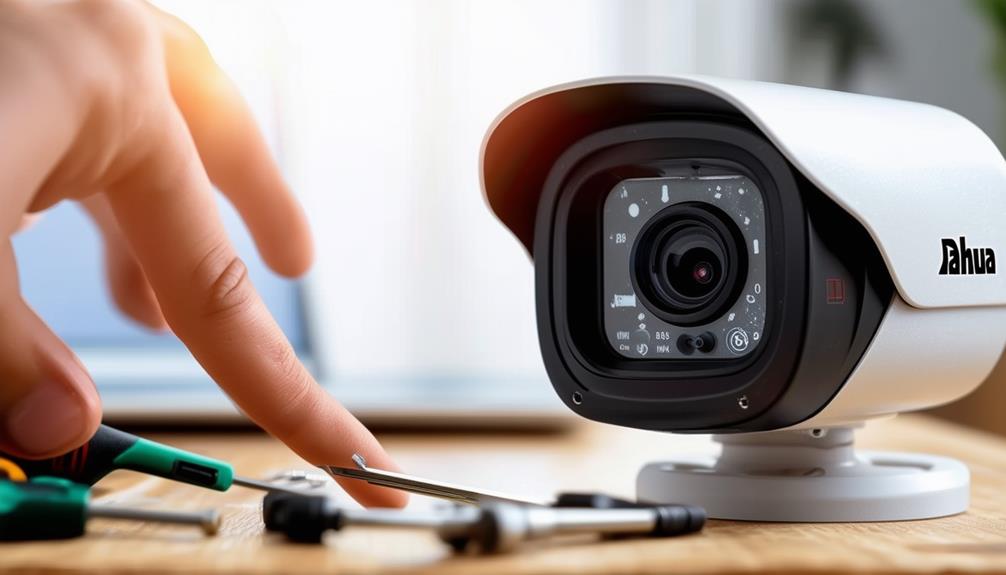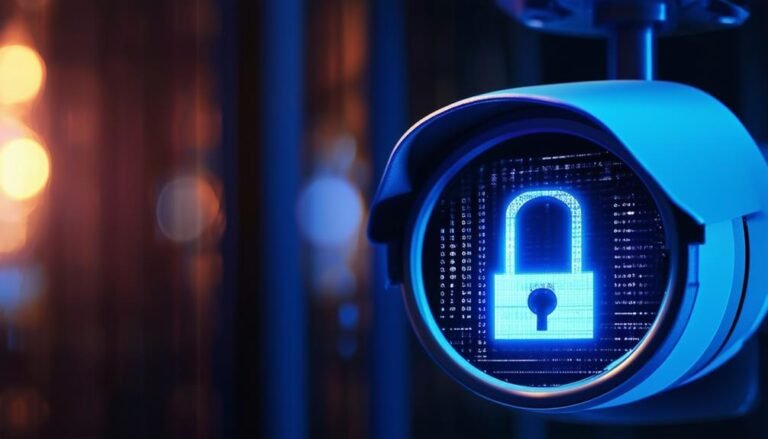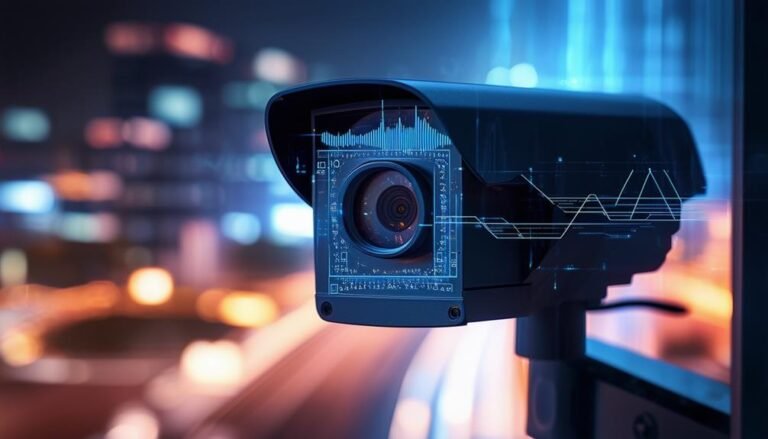To default your Dahua IP camera, start by locating the reset button, usually a small recessed one. Power off the camera first to avoid any electrical issues. Then, power it back on while holding the reset button for 10-15 seconds until the LED indicator blinks. Once it stabilizes, release the button and reboot the camera. After the reset, connect it to your network using an Ethernet cable and access the interface through the default IP address. You can customize your settings afterward for peak performance. If you need further guidance, you’re just a few steps away from more details.
Understanding the Need to Reset
Why might you need to reset your Dahua IP camera? There are several reasons that can lead you to this decision. First off, if you’ve forgotten your login credentials, getting back into your camera can feel impossible. A reset will clear those settings, allowing you to regain access. But it’s not just about forgotten passwords; misconfigurations can also occur. If you’ve changed settings and things aren’t working as they should, a reset can bring your camera back to a clean slate, free from the chaos of incorrect settings.
Another reason you might consider a reset is if you’re moving the camera to a new location or transferring it to someone else. You’ll want to verify that all previous configurations and data are wiped clean, allowing for a fresh start. This not only provides peace of mind but also enhances security by removing any potential vulnerabilities tied to the old configurations.
Lastly, if your camera’s performance is lacking—like lagging images or connectivity issues—a reset can help. Sometimes, technology just needs a fresh beginning to function effectively. By resetting your Dahua IP camera, you’re taking back control, emphasizing your desire for seamless surveillance and the freedom to manage your security effectively. In a world where you call the shots, verifying your camera works for you is essential. Remember, resetting your camera can be a straightforward way to reclaim that control.
Preparing for the Reset Process
Before you plunge into resetting your Dahua IP camera, it’s important to gather everything you’ll need to assure a smooth process. You don’t want to find yourself scrambling for tools right when you need them. Here’s a quick checklist to help you prepare.
| Item | Purpose | Availability |
|---|---|---|
| Screwdriver | To open the camera casing | Check your toolbox |
| Power source | To ascertain the camera’s operational | Use the original adapter |
| Reset button access | To perform the reset | Locate the button |
As you gather these items, take a moment to verify that your camera is properly powered off before starting. This will prevent any electrical mishaps. If you’re unsure about the layout of your camera, consult the user manual or look up a diagram online. Familiarizing yourself with the camera’s components can save you time and frustration.
Additionally, consider setting aside a dedicated workspace where you can focus on the reset process. A clear and organized area can help you avoid losing small parts and keep everything within arm’s reach.
Lastly, take a deep breath and remind yourself that you’re taking this step to regain control over your camera. Trust the process, and you’ll be well on your way to having your Dahua IP camera reset and ready for action!
Step-by-Step Reset Instructions
Ready to reset your Dahua IP camera? You’re taking the first step toward regaining full control. Follow these simple steps, and you’ll be back in action in no time.
First, locate the reset button on your camera. It’s usually a small, recessed button found on the back or bottom. You might need a pin or paperclip to press it. Once you’ve got that ready, power on your camera.
Next, press and hold the reset button for about 10-15 seconds. You’ll notice the camera’s LED indicator blinking. This means it’s processing the reset. Keep holding that button until the lights stabilize, indicating that the reset is complete.
Now, release the button and give your camera a moment to reboot. It should take just a minute or two. Once it’s back online, your camera will revert to its factory settings, freeing you from any previous configurations that were holding you back.
Finally, after the reboot, you’ll need to reconnect to your camera. Make sure you have the default IP address handy, usually found in the camera’s manual. Use this to access the camera’s interface and start fresh.
That’s it! You’ve successfully reset your Dahua IP camera. Enjoy the freedom of a clean slate and get ready to set it up just the way you want.
Configuring Your Camera After Reset
Now that you’ve reset your Dahua IP camera, it’s time to configure it to meet your specific needs. Start by connecting your camera to your network. Use an Ethernet cable for a more stable connection during setup. Once connected, access the camera’s interface via a web browser. Enter the camera’s default IP address, usually something like 192.168.1.108. You’ll be prompted to log in; the default username and password are often admin/admin, but make sure to change these for security.
After logging in, navigate to the settings menu. This is where you can customize various options. Set up your camera’s network settings to match your local network. Adjust the IP address, subnet mask, gateway, and DNS server if necessary. It’s essential to verify that your camera’s IP address doesn’t conflict with other devices on your network.
Next, configure video settings. Choose the resolution, frame rate, and bitrate based on your needs—higher settings take up more bandwidth but offer better quality. You’ll also want to set up motion detection zones and sensitivity levels to minimize false alerts.
Lastly, don’t forget to enable remote access if you want to monitor your camera from anywhere. Set up a DDNS service or use the P2P feature for easier access. With your camera configured, you’re free to enjoy enhanced security tailored to your lifestyle. Remember to save all changes before logging out!
Troubleshooting Common Issues
While configuring your Dahua IP camera can be straightforward, you might encounter some common issues that can hinder the setup process. One frequent problem is connectivity. If your camera isn’t connecting to the network, double-check your Ethernet cable and router settings. Verify your camera’s IP address is in the same range as your network. A simple reboot of the router might also do the trick.
Another issue could be related to your camera’s power supply. If you’re not getting any response, confirm that the power adapter is functioning correctly and that the camera is plugged in properly. If the camera’s LED indicators aren’t lighting up, it’s time to troubleshoot the power connection.
You might also face difficulties with the camera’s software. If you’re unable to access the camera through the web interface, make sure you’re using the correct browser and that any necessary plugins are installed. Clearing your browser’s cache can sometimes resolve this.
Lastly, if you’re getting error messages while trying to set up motion detection or recording features, revisit the settings to verify everything is configured according to your preferences. Sometimes, a simple reset can clear out stubborn glitches.
Don’t let these issues frustrate you. With a little patience and persistence, you can overcome them and enjoy the freedom of enhanced security that your Dahua IP camera provides. Happy monitoring!
Frequently Asked Questions
Will Resetting My Dahua Camera Erase All Recorded Footage?
Resetting your Dahua camera typically won’t erase recorded footage stored on an external device or cloud. However, if your camera’s settings are tied to internal storage, a reset might affect those recordings. It’s essential to back up any important footage before proceeding. You’ll want to check your camera’s specific documentation for details, as different models might have varying features. Being informed helps you maintain your freedom of access to significant recordings.
Can I Reset the Camera Remotely?
You can’t reset the camera remotely if it’s not designed for that feature. Most cameras require physical access to perform a reset. If you’re looking for convenience, consider models that offer remote management options. It’s crucial to check the specifications of your device. Always remember that a reset might erase settings or recordings, so make sure you’ve backed up anything important before taking any action. Freedom in tech often comes with responsibility!
Is There a Way to Recover Lost Camera Settings?
If you’ve lost your camera settings, there are a few ways to recover them. First, check if you’ve saved a backup of your settings; many devices allow you to export configurations. If you haven’t, try accessing the camera’s web interface, as some settings might still be there. Finally, consider consulting the user manual for any tips on recovery. Don’t hesitate to reach out to customer support for additional help if needed!
How Often Should I Reset My Dahua Camera?
Think of your Dahua camera like a garden; it needs care and occasional pruning to flourish. Resetting it too often can disrupt its growth, so you should only do it when necessary. If you notice persistent issues or settings changes you can’t resolve, a reset can clear the weeds. Generally, once a year or whenever you face significant problems is a good rule. Freedom in your surveillance system comes from balance and maintenance.
Does Resetting Void the Camera’s Warranty?
Resetting your Dahua camera typically doesn’t void the warranty, but it’s always best to check the specific terms. Manufacturers often allow resets as part of normal use. However, if you’re making unauthorized modifications or if the reset leads to damage, that could affect your coverage. Keep your warranty details handy, and if you’re unsure, reach out to customer support for clarity. You deserve to know your rights when it comes to your equipment!



